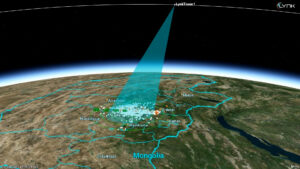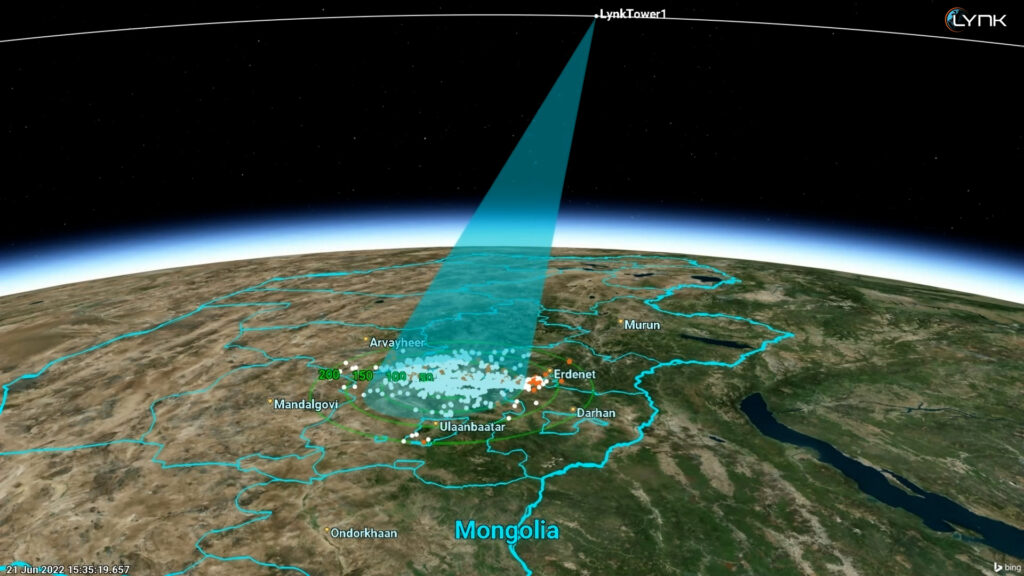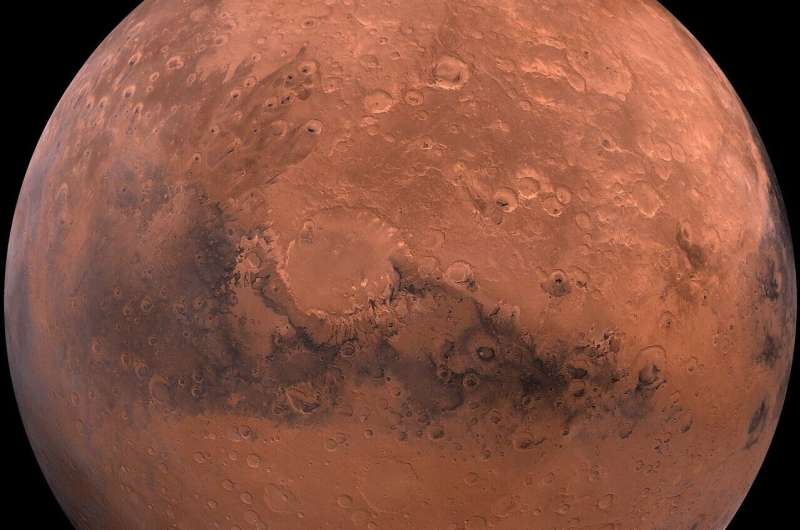Additional vendors selected for DoD’s low Earth orbit satellite services contract
Monday, 27 November 2023 16:30

China makes progress on Raptor-like engines for super heavy rocket
Monday, 27 November 2023 11:56

NASA feels a 'sense of urgency' to get to Mars: Idaho scientists could help us get there
Monday, 27 November 2023 11:33
China has repeatedly stunned the U.S. intelligence community in the last five years with rapid progress in its space exploration program, landing a rover on the far side of the moon and completing its very own space station orbiting Earth.
Their advances have established that a new space race is on between Washington and Beijing—this time with the ultimate goal of sending a crewed mission to Mars, each vying to be the first to land humans on another planet.
America's success may come down to a team of scientists based out of Idaho Falls.
Engineers at the Energy Department's Idaho National Laboratory are leading a nationwide team of scientists to enhance the capabilities of nuclear thermal propulsion, a technology that NASA hopes will cut the travel time to Mars by half.
It is an ambitious project that could transform the future of human space travel.
"What NASA ultimately is looking for is a nuclear thermal solution to get to Mars," Sebastian Corbisiero, senior technical advisor for advanced concepts at the Idaho National Laboratory, told McClatchy in an interview.
Space Team Europe for Euclid: Jean-Charles Cuillandre
Monday, 27 November 2023 11:30 Video:
00:07:54
Video:
00:07:54
Focus on Euclid with Jean-Charles Cuillandre: “What we see in the first Euclid images is a promise of what will come in the future.”
Jean-Charles Cuillandre, astronomer at CEA Paris-Saclay, explains that he was “blown away” when he saw the first full-colour images captured by ESA’s recently launched Euclid space telescope.
Being a specialist of wide-field imaging, Jean-Charles was not only involved in the programme committee that selected the celestial targets for the ESA Euclid’s ‘Early Release Observations’, but he was also in charge of processing the data both for their scientific and their outreach value.
Jean-Charles expected the resulting
Spaceflux and UK Space Command to boost GEO monitoring
Sunday, 26 November 2023 06:39 Spaceflux, a notable UK space technology company established in 2022, has recently been awarded significant contracts by the UK Space Command and the UK Space Agency. This collaboration is set to significantly enhance the United Kingdom's Space Domain Awareness (SDA) capabilities, focusing particularly on monitoring satellites in the strategically crucial geostationary orbit (GEO).
The com
Spaceflux, a notable UK space technology company established in 2022, has recently been awarded significant contracts by the UK Space Command and the UK Space Agency. This collaboration is set to significantly enhance the United Kingdom's Space Domain Awareness (SDA) capabilities, focusing particularly on monitoring satellites in the strategically crucial geostationary orbit (GEO).
The com Korean space race? North and South chase spy satellites
Sunday, 26 November 2023 06:39 North Korea claimed Wednesday to have successfully put its first military surveillance satellite into orbit, with the South also preparing to send up its first spy satellite later this month.
The two launch attempts, set to come in such quick succession, appear to be the beginnings of a space race on the Korean peninsula.
Here, AFP takes a look at what we know about the new competition b
North Korea claimed Wednesday to have successfully put its first military surveillance satellite into orbit, with the South also preparing to send up its first spy satellite later this month.
The two launch attempts, set to come in such quick succession, appear to be the beginnings of a space race on the Korean peninsula.
Here, AFP takes a look at what we know about the new competition b MDA initiates work on a new digital satellite constellation
Sunday, 26 November 2023 06:39 MDA Ltd. (TSX: MDA), a leading provider of advanced technology and services to the rapidly expanding global space industry, has received an Authorization to Proceed (ATP) contract from an undisclosed customer to start work on a new Non-Geostationary Orbit (NGSO)* satellite constellation. The ATP, valued at approximately $180 million, is to immediately commence engineering and programmatic activi
MDA Ltd. (TSX: MDA), a leading provider of advanced technology and services to the rapidly expanding global space industry, has received an Authorization to Proceed (ATP) contract from an undisclosed customer to start work on a new Non-Geostationary Orbit (NGSO)* satellite constellation. The ATP, valued at approximately $180 million, is to immediately commence engineering and programmatic activi Pennsylvania Invests Millions in Astrobotic Technology
Sunday, 26 November 2023 06:39 Astrobotic Technology, a leading space exploration company, is expanding its presence in Pittsburgh, Pennsylvania, with an ambitious plan to create a 'space campus'. This move is set to bolster the region's reputation as a hub for innovation and space technology.
The company, which was spun out of Carnegie Mellon University in 2007 by William "Red" Whitaker, has acquired a five-story, 46,0
Astrobotic Technology, a leading space exploration company, is expanding its presence in Pittsburgh, Pennsylvania, with an ambitious plan to create a 'space campus'. This move is set to bolster the region's reputation as a hub for innovation and space technology.
The company, which was spun out of Carnegie Mellon University in 2007 by William "Red" Whitaker, has acquired a five-story, 46,0 Satellogic receives NOAA license to expand US Govt business
Sunday, 26 November 2023 06:39 Satellogic Inc. (NASDAQ: SATL), a frontrunner in the Earth Observation (EO) industry, has achieved a significant milestone in its U.S. expansion strategy. The company announced that it has been granted a remote sensing license by the National Oceanic and Atmospheric Administration (NOAA). This license is a strategic move for Satellogic, aligning with its ambition to leverage high-value opportuni
Satellogic Inc. (NASDAQ: SATL), a frontrunner in the Earth Observation (EO) industry, has achieved a significant milestone in its U.S. expansion strategy. The company announced that it has been granted a remote sensing license by the National Oceanic and Atmospheric Administration (NOAA). This license is a strategic move for Satellogic, aligning with its ambition to leverage high-value opportuni China Enhances Ocean Observation Capabilities with Launch of HY-3A Satellite
Sunday, 26 November 2023 06:39 In a significant advancement in its space capabilities, China has successfully launched the HY-3A, a new-generation ocean observation satellite. The launch, which took place on Thursday, marks China's 53rd rocket launch this year, underscoring the country's accelerated pace in space endeavors.
The HY-3A satellite was lofted into space atop a Long March 2C carrier rocket from the Jiuquan Sa
In a significant advancement in its space capabilities, China has successfully launched the HY-3A, a new-generation ocean observation satellite. The launch, which took place on Thursday, marks China's 53rd rocket launch this year, underscoring the country's accelerated pace in space endeavors.
The HY-3A satellite was lofted into space atop a Long March 2C carrier rocket from the Jiuquan Sa Heat Shield demo passes the test dubbed 'Just flawless'
Sunday, 26 November 2023 06:39 Hampton VA (SPX) Nov 20, 2023
A little more than a year ago, a NASA flight test article came screaming back from space at more than 18,000 mph, reaching temperatures of nearly 2,700 degrees Fahrenheit before gently splashing down in the Pacific Ocean. At that moment, it became the largest blunt body - a type of reentry vehicle that creates a heat-deflecting shockwave - ever to reenter Earth's a
Hampton VA (SPX) Nov 20, 2023
A little more than a year ago, a NASA flight test article came screaming back from space at more than 18,000 mph, reaching temperatures of nearly 2,700 degrees Fahrenheit before gently splashing down in the Pacific Ocean. At that moment, it became the largest blunt body - a type of reentry vehicle that creates a heat-deflecting shockwave - ever to reenter Earth's a Lockheed Martin opens $16.5M Missile Defense Lab
Sunday, 26 November 2023 06:39 In a significant development for the U.S. missile defense capabilities, Lockheed Martin (NYSE: LMT), a global leader in aerospace and defense technologies, unveiled a new state-of-the-art engineering facility at its Huntsville campus.
The $16.5 million Missile System Integration Lab (MSIL) stands as a testament to Lockheed Martin's commitment to advancing missile defense innovation and str
In a significant development for the U.S. missile defense capabilities, Lockheed Martin (NYSE: LMT), a global leader in aerospace and defense technologies, unveiled a new state-of-the-art engineering facility at its Huntsville campus.
The $16.5 million Missile System Integration Lab (MSIL) stands as a testament to Lockheed Martin's commitment to advancing missile defense innovation and str Trailblazing New Earth Satellite Put to Test in Preparation for Launch
Sunday, 26 November 2023 06:39 During three weeks in a thermal vacuum chamber in Bengaluru, India, the joint NASA-ISRO satellite demonstrated its hardiness in a harsh, space-like environment.
NISAR, the trailblazing Earth-observing radar satellite being developed by the United States and Indian space agencies, passed a major milestone on Nov. 13, emerging from a 21-day test aimed at evaluating its ability to function in
During three weeks in a thermal vacuum chamber in Bengaluru, India, the joint NASA-ISRO satellite demonstrated its hardiness in a harsh, space-like environment.
NISAR, the trailblazing Earth-observing radar satellite being developed by the United States and Indian space agencies, passed a major milestone on Nov. 13, emerging from a 21-day test aimed at evaluating its ability to function in 




